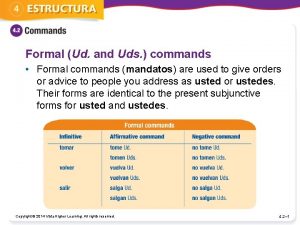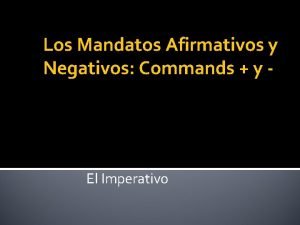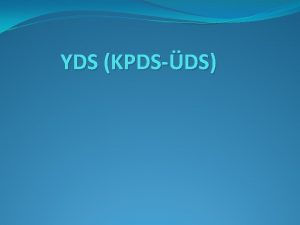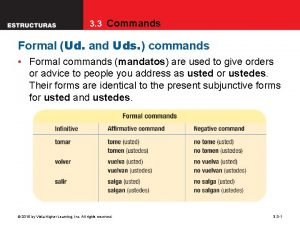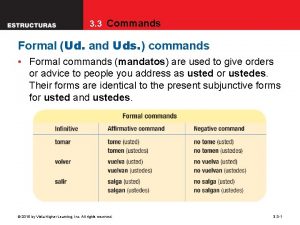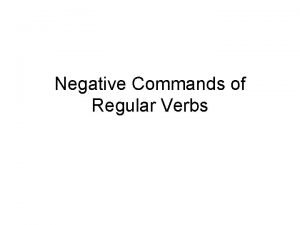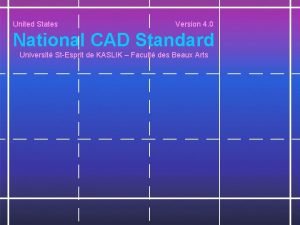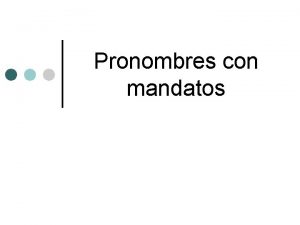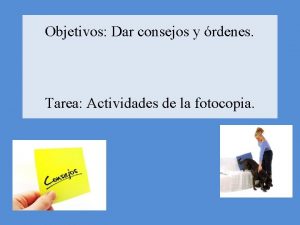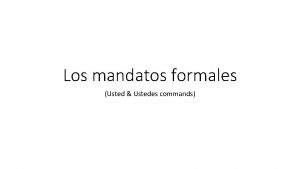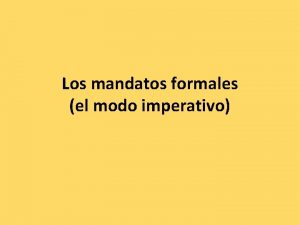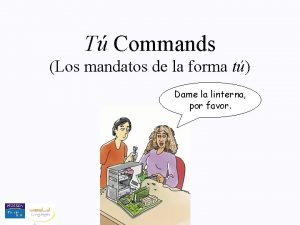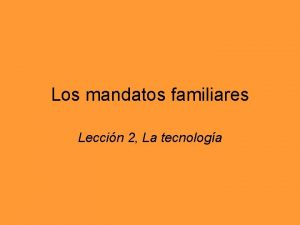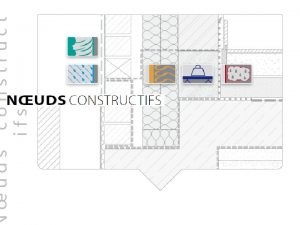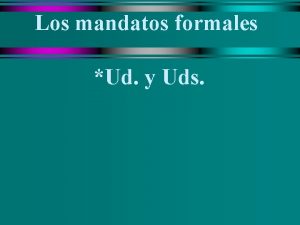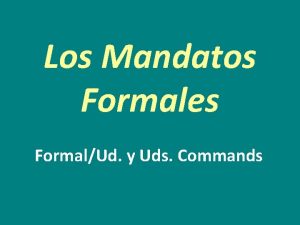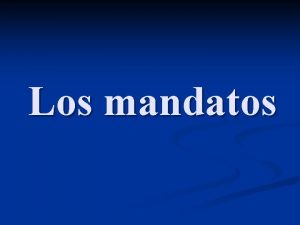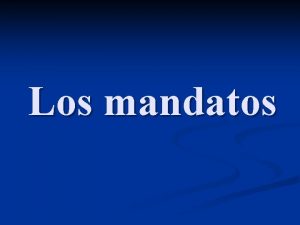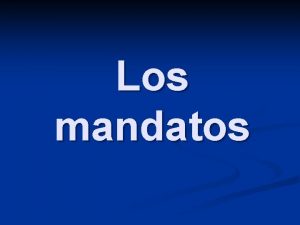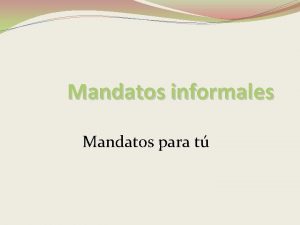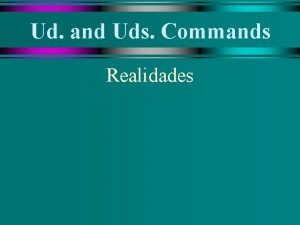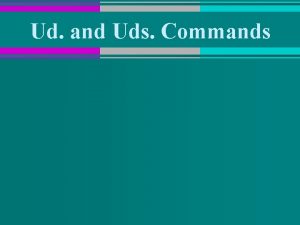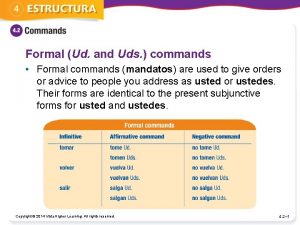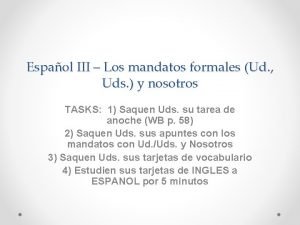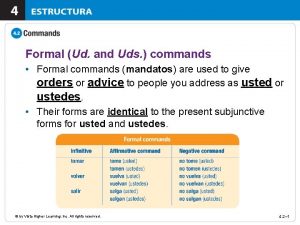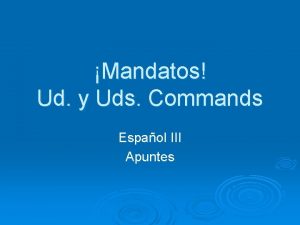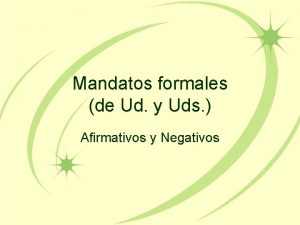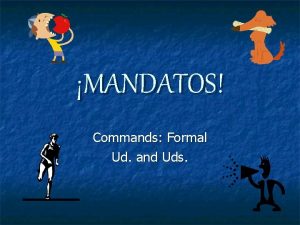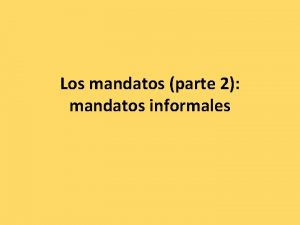Gramtica 4 2 Mandatos Ud Uds y T

























- Slides: 25

Gramática 4. 2 Mandatos (Ud. /Uds. y Tú Commands)

¿Qué es un mandato? • Mandato is the word for command. It is the imperative form (la forma imperativa).

How to form Ud. mandatos • How to form Usted commands: 1. Start with yo form of the present tense 2. Drop the “o” 3. -car (c qu), -gar (g gu), -zar (z c) 4. OPPOSITES! add –e for –ar verbs; add –a for –er/ir verbs • poner pongo pong PONGA • sacar saco sac saqu SAQUE

Práctica • comer – como coma • practicar – practico practic practique • sudar – sudo sude • jugar – juego juegue

Ud. Mandatos irregulares. Yay! • dar dé • ser sea • ir vaya • saber sepa • estar esté

How to form Uds. mandatos 1. Start with yo form of present tense 2. Drop the “o” 3. -car (c qu), -gar (g gu), -zar (z c) 4. OPPOSITES! add –en for –ar verbs add –an for –er/ir verbs • poner pongo pong PONGAN • sacar saco sac saqu SAQUEN

Práctica • • bailar ______ Bailen hacer la tarea ______ Hagan la tarea decir la verdad _______ Digan la verdad Saquen las fotos sacar las fotos _______

Uds. Mandatos irregulares • dar den • ser sean • ir vayan • saber sepan • estar estén

Mandatos negativos: Ud. y Uds. • To create a negative Ud. Or Uds. mandato, simply place NO before the command form. • ¡Coma los tacos! ¡No coma los tacos!

Mandatos and Pronoun Placement • When using a direct, indirect or reflexive pronoun with a command—ATTACH the pronoun to the end of the command. – Comer los tacos (Ud. ) Cómalos – Hacer la tarea (Ud. ) Hágala – Levantarse(Uds. ) Levántense ***reflexive pronoun will always be “se” for Ud. and Uds. commands.

Accent placement on mandatos with pronouns • When attaching pronouns to a mandato, an accent is needed. • Start with the original mandato and count back 2 syllables that is where the accent goes. • Bañarse ¡Bá ñe se! 2 1 • Hacer la tarea ¡Há ga la! 2 1

Mandatos negativos and pronoun placement • Pronouns will be placed BEFORE the mandato and NO ACCENT is needed. • ¡Cómalos! ¡No los coma!

One syllable mandatos with pronouns • NO accent is needed with a single object or reflexive pronoun. – Dar dé – Dar el regalo Delo • Accent goes over vowel in the mandato when there is a double object pronoun. – Dar el regalo a nosotros Dénoslo ***one syllable commands are much more common with informal (tú) commands.

Ejemplos • Reflexive verbs (always use se!) – Despertarse Despiértese No se despierte • Direct Object Pronoun – Jugar al fútbol Juéguelo No lo juegue. • Indirect Object Pronoun – Dar a ella Dele No le dé. • Double Object Pronoun – Decir la verdad a nosotros Díganosla No nos la diga. – Ponerse la ropa Póngasela No se la ponga

Ejemplos *2 -Pronoun Placement rules: • • • Indirect before direct (I. D. card!!!) Reflexive before direct “se” it don’t “le” it (Never “le lo” “se lo”) – Dar el regalo a tu abuelo Délelo Déselo No se lo dé

What if there are two vowels in a syllable? • ¿Qué es un Diptongo? – The combination of two vowels that share one syllable! • Accent goes over strong vowel. – – – • strong (a, e, o) weak (u, i) strong + weak=1 syllable (peinarse) strong + strong= 2 syllables (leer) Ej: afeitarse Afeitese Aféitese • acostarse Acuestese Acuéstese If two weak vowels are together (u & i), the accent is placed on the SECOND vowel if it is to be pronounced as one syllable! – cuidar a los niños Cuidalos Cuídalos

Práctica: Escriban los mandatos (aff y neg) en la forma Ud. 1. hacer la tarea – __________ Hágala – __________ No la haga 2. practicar los deportes – __________ Practíquelos – __________ No los practique 3. recoger la basura (yo=recojo) – __________ Recójala – __________ No la recoja 4. dar un regalo a mí Démelo – ____________________ No me lo dé

Práctica: Escriban los mandatos (aff y neg) en la forma Ud. 5. vestirse - ________ Vístase - ________ No se vista 6. Oír la música - ________ Óigala - ________ No la oiga 7. empezar la tarea - ________ Empiécela - ________ No la empiece 8. traer las galletas a tu amigo. - ________ Tráigaselas - ________ No se las traiga

Mandatos de tú • To form affirmative commands, take third person singular form in the present tense. • comer come • abrir abre • escribir escribe • escuchar escucha

Mandatos irregulares de tú • • hacer haz tener ten poner pon salir sal venir ven ser sé decir di ir ve *notice that all irregular tú comands are one syllable. When adding a Direct or Indirect Object pronoun, there is NO ACCENT! hacer la tarea Hazla

Mandatos negativos de tú 1. Start with yo form of present tense 2. Drop the “o” 3. car (c qu), gar (g gu), zar (z c) 4. OPPOSITES! add –es for –ar verbs; add –as for –er/ir verbs • poner pongo pong NO PONGAS • sacar saco sac saqu NO SAQUES

Mandatos negativos irregulares • dar no des • ser no seas • ir no vayas • saber no sepas • estar no estés

Pronoun Placement • Follow rules for Ud. and Uds. Accent Placement • Follow rules for Ud. y Uds.

Práctica (tú commands!) • Poner, tener, salir, ir • ________, _______ pon sal ve ten • No poner, no tener, no salir, no ir • ____, no pongas ____, no tengas ____, no salgas ____ no vayas • Hacer la tarea • ______ Hazla • No dar el regalo a mí • ______ No me lo des

Práctica (tú commands!) • Divertirse • ____ Diviértete • No acostarse tarde • _________ No te acuestes tarde • Traer las gafas de sol a mi • _____ Tráemelas • No bañarse • ______ No te bañes
 Afirmativos y negativos
Afirmativos y negativos Mandatos afirmativos y negativos con ud. y uds. (p. 123)
Mandatos afirmativos y negativos con ud. y uds. (p. 123) Mandatos afirmativos y negativos conjugations
Mandatos afirmativos y negativos conjugations Que es la gramtica
Que es la gramtica Gramtica inglesa
Gramtica inglesa Youtuvs
Youtuvs Buscar ud command
Buscar ud command Traer familiar command
Traer familiar command üds nedir kimler girebilir
üds nedir kimler girebilir Ud and uds commands
Ud and uds commands Uds commands
Uds commands Informal commands spanish
Informal commands spanish Csi uniform drawing system
Csi uniform drawing system Uds kienzle
Uds kienzle Que son mandatos
Que son mandatos Mandatos con nosotros
Mandatos con nosotros Dar mandato afirmativo
Dar mandato afirmativo Mantener formal command
Mantener formal command Mandatos formales
Mandatos formales Criticar nosotros command
Criticar nosotros command Verbos irregulares en el imperativo
Verbos irregulares en el imperativo Salir mandatos formales
Salir mandatos formales Aspectos positivos y negativos de la dolarizacion
Aspectos positivos y negativos de la dolarizacion Los mandatos informales
Los mandatos informales Mandatos spanish
Mandatos spanish Primero (1) 1 of 8 (prender) tu computadora.
Primero (1) 1 of 8 (prender) tu computadora.

